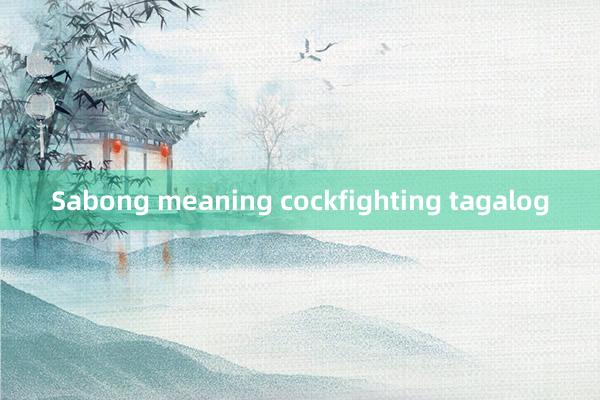
Sabong: The Meaning of Cockfighting in Tagalog
Sabong, known as cockfighting in English, is a deeply rooted tradition in the Philippines, especially among the Tagalog-speaking population. This centuries-old sport has played a significant role in Filipino culture and society, shaping social gatherings, celebrations, and even the local economy. To understand the full meaning of sabong, it’s essential to look into its historical context, cultural significance, and how it continues to thrive in the modern era.
Historical Background of Sabong
The practice of cockfighting in the Philippines dates back to pre-colonial times. Historical accounts suggest that the indigenous peoples of the archipelago were already engaging in sabong before the Spanish colonizers arrived in the 16th century. The sport's exact origins are unclear, but some historians believe that it was introduced by traders from Southeast Asia or other neighboring regions. What is known is that the sport quickly became an integral part of Filipino society.
During the Spanish colonial period, sabong gained even more prominence. The Spanish authorities, realizing its popularity among the locals, began regulating and taxing the activity. Cockfighting arenas, or sabungan, were established in many towns, and the sport became an important source of revenue for the colonial government. This regulation not only cemented sabong's place in Filipino culture but also linked it to economic and political structures.
The Rules and Rituals of Sabong
Sabong is not just about watching two roosters fight. It involves a set of complex rituals and practices that have been passed down through generations. The roosters, or tari, are carefully selected and trained by their owners. These birds are bred specifically for their strength, agility, and fighting prowess. Months of preparation go into raising a fighting rooster, from its diet to its exercise regimen.
On the day of the fight,phcrown roosters are fitted with sharp blades, phim xet đồng tính nữ known as gafas or tari, phim sex móc lồn nhật bản on their legs. These blades are designed to make the fight more lethal, often leading to a quick resolution. The matches take place in a circular arena, where spectators gather to watch and place bets. Betting is a significant part of the sabong experience, with onlookers wagering large sums of money on their preferred rooster. The tension and excitement in the air are palpable as the fight begins, and the outcome can be decided in mere seconds.
Before the match, there is a ritualistic weighing and comparing of the roosters to ensure a fair fight. Prayers and blessings are sometimes offered for the safety of the birds, and a sense of respect surrounds the event despite its violent nature. For many participants, sabong is not just a sport but also a form of tradition that holds deep cultural meaning.
Cultural Significance of Sabong in Tagalog Communities
go88 hitIn Tagalog-speaking regions of the Philippines, sabong holds a special place in community life. It’s more than just entertainment; it is a social activity that brings people together. The sabungan serves as a gathering place where locals exchange stories, discuss politics, and foster camaraderie. For many, attending a sabong match is a way to connect with neighbors and participate in a shared cultural experience.
The sport also plays a role in religious festivals and local celebrations. It is not uncommon to see cockfights organized during town fiestas or holidays, where the proceeds may go toward funding community projects or church renovations. In this way, sabong has become intertwined with both secular and spiritual aspects of Filipino life.
Despite its controversial nature, sabong has maintained its place in the fabric of Filipino society because of its deep cultural roots. For some, it represents a link to their ancestors, a practice passed down from generation to generation.
Modern Sabong: Thriving Amid Controversy
In recent years, sabong has faced criticism from animal rights activists who argue that the sport is cruel and inhumane. There have been calls to ban cockfighting or at least regulate it more strictly. In response, the Philippine government has enacted laws to control the practice, limiting the days on which cockfights can be held and requiring licenses for those involved.
Despite these challenges, sabong continues to thrive in the Philippines, particularly in rural areas. The rise of e-sabong, or online cockfighting, has introduced the sport to a global audience. E-sabong allows people to watch and bet on matches remotely, expanding the reach of the sport beyond the traditional sabungan. This modern twist on an ancient practice has sparked both excitement and debate, as it raises new questions about regulation, ethics, and the role of technology in cultural traditions.
Conclusion
Sabong, or cockfighting, is more than just a sport in the Philippines—it’s a cultural institution with deep historical roots, especially among Tagalog-speaking communities. While the practice has evolved over the years and faced modern challenges, its significance remains strong. For many Filipinos, sabong is a way of life, a connection to their heritage, and a symbol of the community spirit that defines the Philippines.
As the country navigates issues of tradition, morality, and modernity, sabong continues to hold its place as both a source of entertainment and a reflection of Filipino identity. Whether celebrated or criticized, its impact on Filipino culture is undeniable, and its legacy is likely to endure for generations to come.
Jilievo Com Login registrationwww.uailde.com


